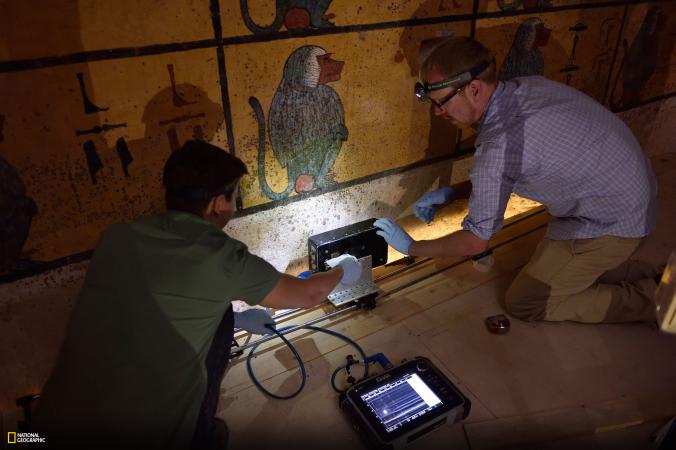
PHOTO: National Geographic
Arguably one of the most important discoveries in Egyptology is still surprising and perplexing archaeologists to this day, according to the experts at the Annual Tutankhamen Grand Egyptian Museum Conference in Cairo, just this past weekend. A controversy over the ancient Egyptian Pharoah’s tomb has been sparked that’s dividing the archaeological community: are there secret rooms in Tutankhamen’s tomb that we haven’t found yet?
Why is this debate just coming up now, you may ask? Well, archaeologists have been speculating for months, apparently, about whether or not there are hidden chambers in the famous pharoah’s tomb. In fact, a laser scan was run on the walls of the tomb by British Egyptologist Nicholas Reeves. Reeves noticed a series of door-like features hidden beneath the paint and decorations and plaster on the north and west walls of the tomb. These findings led him to pose the theory to the archaeological community that there might be something beyond those walls that we haven’t found yet. The question of whether or not there might be secret rooms in the tomb is up in the air. Last fall, another scan was run, this time a thermographic one. It revealed certain anomalies that corresponded with the door-like features, and a physical inspection also seemed to suggest that something might lie beyond the north and west walls. And, just last November, a radar scan run by Hirokatsu Wantanabe detected possible voids and metallic objects beyond the same walls as well. The evidence seemed overwhelming. The debate was brought up when officials in the community revealed that another scan of the same walls has come up with a contradictory result.
In March of this year, National Geographic’s radar technicians attempted to replicate Wantanabe’s scans. They found nothing. The tension at the conference only thickened when the former minister of antiquities, Zahi Hawass accused another former minister of antiquities, Eldamaty, of secretly submitting paperwork to the Egyptian authorities to authorize drilling in Tutankhamen’s tomb. Eldamaty denied these accusations, of course, angrily saying that he would never do such a thing unless he was 100% certain that there was another chamber.

PHOTO: National Geographic
Apparently, many specialists in ground penetrating radar, or GPR, as it’s referred to in the archaeological community, have voiced criticism of Wantanabe’s scans. They say there’s nothing there at all. It’s even more suspicious that Wantanabe has not released the raw data from his scans for review, saying that he’s altered his equipment so much that it would be unreadable to other experts. However, while he is a controversial figure in Japan and has a history of jumping to conclusions, his peers say that it’s unusual for Wantanabe to be wrong like this.
Even after all this controversy over whether or not something is actually there, the very idea that there might be is too tempting to pass up. It’s likely that the Egyptian Ministry of Antiquities will approve another set of scans of Tutankhamen’s tomb, just to make sure that they haven’t missed anything. The results of these future scans are likely to decide the fate of Nicholas Reeves’ theory. The current Minister of Antiquities is calling a committee to decide what must be done. No individual must decide the fate of the tomb, he said, and he’s right. The history in Tutankhamen’s tomb is too important to the story of the human race for anyone to decide on their own to drill into the walls, or to leave them alone. We shall see in the coming months whether or not there really is more to be found in the ancient Pharoah’s tomb. Either way, it’s truly, as the first man who saw it said, full of unimaginable wonders.

